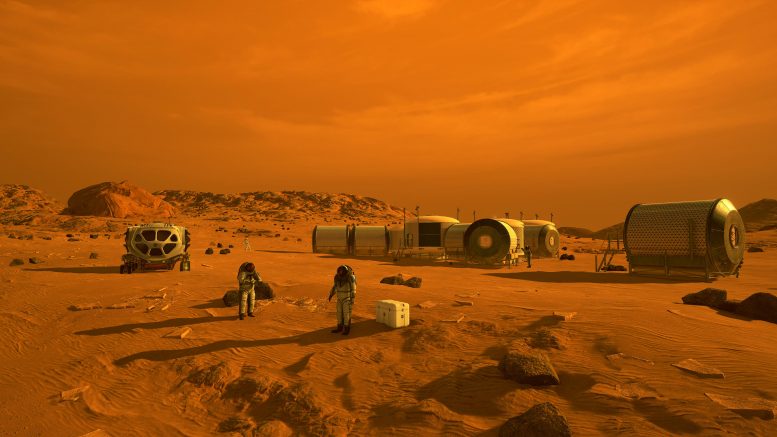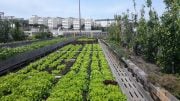
This artist’s concept depicts astronauts and human habitats on Mars. NASA’s Mars 2020 rover will carry a number of technologies that could make Mars safer and easier to explore for humans. Credit: NASA
Mars is a lifeless wasteland for more than one reason. Not only are the temperatures and lack of water difficult for life to deal with, the lack of a magnetic field means radiation constantly pummels the surface. If humans ever plan to spend prolonged periods of time on the red planet, they’ll need to support an additional type of life – crops. However, it appears that even greenhouses on the surface won’t do enough to protect their plants from the deadly radiation of the Martian surface, at least according to a new paper published by researchers at Wageningen University and the Delft University of Technology.
Ideally, agriculture on the Maritan surface would consist of greenhouse domes and allow what limited sunlight hits the planet to make it through to the crops they house directly. However, current technology greenhouse glass is incapable of blocking the deadly gamma radiation that constantly irradiates Mars. Those gamma radiation levels, which are about 17 times higher on Mars than on Earth, are enough to affect crops grown in greenhouses on the surface significantly.
UT video discussing how to live with in situ resource utilization on Mars.
The researchers ran an experiment where they planted garden cress and rye and measured the crop output of a group irradiated with Martian levels of gamma radiation with those grown in a “normal” environment with only Earth-level radiation. The crops in the irradiated group ended up as dwarves, with brown leaves, and resulted in a significantly decreased harvest after 28 days of growth.
To mimic the gamma radiation environment, Nyncke Tack, an undergraduate researcher who performed much of the work for the project, used 5 separate cobalt-60 radiation sources. These were scattered evenly overhead of the test crops to create a “radiation plane” similar to the ever-present radiation field on Mars.
UT video about colonizing the inner solar system.
Other confounding factors, including adding beta and alpha radiation, could also contribute to crop deterioration, though solid objects more easily stop those types of radiation. The research team, who was not surprised by their findings, suggests building underground farms where the planet’s regolith blocks most if not all of that radiation. This would have the obvious disadvantage of losing access to sunlight, but would have the added benefit of being a much more controllable environment, with LEDs and temperature control filling in for environmental conditions on the surface.
To prove their theory, the team is next commandeering a Cold War-era bunker in the Netherlands to see if their same irradiation experiments affect crops grown inside if the irradiation is coming from outside. While not a direct analog for Martian regolith, it’s a novel approach to understanding how humans might eventually farm the sky.
Adapted from an article originally published on Universe Today.









Glass would be a waste, but polycarbonate may be used for a ballistic barrier and Radium ClearView is already blending the plastic with their shielding solution.
It looks like ClearView has significant weight advantages over lead or leaded glass. Is the shield filled with a liquid that would drain out if the shield took a hit from a supersonic meteorite?
Leaded glass does a good job of shielding against gamma rays. Another approach would be to use mirrors to reflect sunlight onto the plants. The gamma rays would not be reflected
However, leaded glass is very heavy and the rocket payload weight has to be minimized to get it off the ground!
Maybe a water-lead/poly combo?
Except for one little thing
Gamma rays possess LESS Energy than cosmic ray particles , yes cosmic rays are actually highly energetic particles
So using a cobalt 60 source could provide a similar scenario
But cosmic “rays” would provide different effects theoretically ???
Provo,right ,the living quarters and green houses will have to be built and shaped just below surface,and or seek for large caves and build them in them,
If Man would just stay at home and clean up their own House ,Problem Solved
Maybe we should try growing large scale crops in space stations first before we start trying to grow on on Mars
Hydroponic system could be useful… If forced to use the caverns of Mars for agriculture.
Most have heard don’t throw rocks if you live in a glass house. You have the whole cosmos throwing rocks at you. Just one leak and everything goes out the window.
Seems to me that initially at least you wouls want to live in at or near a trench, either natural or artificial. All the advantages of being underground without the work.
The solution is obvious.large mirrors can reflect light into underground caverns. They will not reflect cosmic radiation.
Well the main reason to have habitats on the surface was easy access to the green house. Now it’s looking like a mars colony is just going to look like a landing pad and all else underground tunnels
I’ve been working on growing food crops in Martian regolith for almost three years now. The lower light intensity, the wavelengths, and the dust in the air all detract from the efficiency of photosynthesis. Greenhouses are very ill-advised. Plus the extreme temperature changes coupled with glass would be hell on the plants. Indoor grow rooms with climate control has proven to be the correct method for me this far.
Water-filled glass panels would be effective.
Sunlight, boom.
Next problem.
Could they develop a solar panel that takes advantage of the extra radiation to produce more electricity to send underground for grow lights?
What about the massive underground lava tubes for hosting human presence?
I have my ticket for Mars leaving in 2026. Over 20 million people worldwide are going through NASA. I can’t wait. Lol
I would like this experiment to be repeated with crops that have phenotypes with high levels of external anthocyanins. The anthocyanins may be able to help. Whether it is enough, I’m not sure, but I’d like to see the data.
I honestly think plants high in anthocyanins will have the best chance of survival on Mars.
Breeding plants to be tolerant of the radiation is one solution. We should be able to evolve crops to survive on Mars. Using mirrors to light underground greenhouses is another way.
Just gotta use a few mirrors and beam the sun down in a cave on a greenhouse. Voila problem solved.
Simple, learn to eat Kudzu. Nothing can hurt Kudzu, and it will grow anywhere. No greenhouse needed. In fact, it’ll probably grow faster with the extra Martian radiation. Problem solved!
Greenhouses may ormay not work, I’m not up on the science. But you can grow weed in a basement or bunker with the appropriare lighting, so it doesn’t seem like growing food would be an insurmountable problem.
Genetically designed plants to sustain an agri/food/minerals needed for crossed human/martian diet will soon be understood and created on certain types of planets/ Mars/ vr46 planet, ertc.
No worries earthlings. See you then.
Why not use “Sun Tunnels” like are used in homes to direct sunlight to the underground gardens? A lot more efficient than solar panels and LED lighting.
Sounds sort of like whats happening at skinwalker ranch in utah
Or maybe just forget greenhouses and use existing led hydroponic systems?
Is it Not TOO Premitive and Too Early to Even Think of Regular Travel to MARS , particularly at the Present AVAILABLE Space Ships which take Nothing Less than 8 to 9 months to Reach MARS ? , Leave alone of Planning to Live there for 6 Months !
It will be WISER to Develop the Available Land on Earth for Living Longer , with Better Health , Reduuced Worries and Fewer People ! Why Not Develope Areas in SAHARA and Other Deserts ! Vast Areas of Greenland , Antarctica and Western Australia for Growth of Vegitation / Trees !?
We already knew this Info from watching Arnold’s Movie (Total Recall)
The solution in my eyes is to grow using artificial light, in a place like a large cave. Don’t worry about using sun for nothing but solar power etc
All initial Lunar or Mars settlements must start in lava tubes. Type in Douglas D Shull on YouTube to see The Mars Society briefings.
Blackened tinted Graphene stained atoms will block a majority of Gamma radiation in such a way that it can be used as an energy distribution source that can power both LED, as well as circulation fans to offer true air/Co2 Delivery to plants and anything else, offering light and energy, and the ability to heat and condense moisture for recycling inside caves or tangently shaded rock overhangs. As we already know, there are enormous caves on Mars whereby graphene shielding can be manufactured from already present elements and sources. Graphene incorporated helmets and space suits can offer limited protection from Gamma radiation and restarting the EMF field of Mars may actually be possible to regenerate with the correct understanding and nuclear generation of transformed Radiation conversion. Silicon glass enclosures could eventually be manufactured inplace offering further surface for Graphene coating to block and even absorb converted radiation into useable power and light.